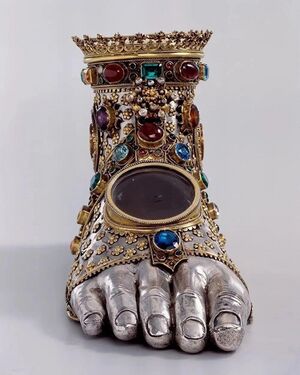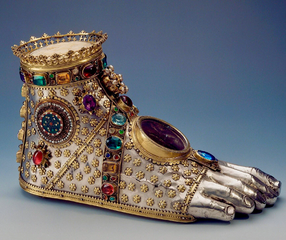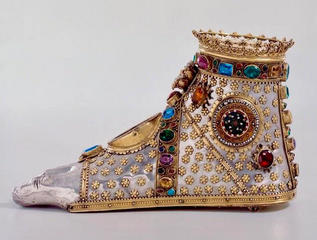Xiaodan's Foot: Difference between revisions
mNo edit summary Tag: 2017 source edit |
|||
| (7 intermediate revisions by one other user not shown) | |||
| Line 10: | Line 10: | ||
| alt2 = | | alt2 = | ||
| image_caption = The foot prosthetic known as '''Xiaodan's Foot''' | | image_caption = The foot prosthetic known as '''Xiaodan's Foot''' | ||
| material = | | material = Silver | ||
| size = Size of a human foot | | size = Size of a human foot | ||
| height = <!-- {{convert|}} --> | | height = <!-- {{convert|}} --> | ||
| Line 31: | Line 31: | ||
| website = | | website = | ||
}} | }} | ||
'''Xiaodan's Foot''' is a silver foot prosthetic that belonged to Emperor Xiaodan of the [[Daxia|Qian dynasty]]. The foot was made by [[Ezechio Destonianus Martoš]] who was the chief silversmith of the Royal Foundry of [[Caphiria]]n Imperator [[Panocoscăr II]], who was the one who commissioned the prosthetic as a gift for the Daxian emperor. It was designed for a right foot and made of shaped silver with fine golden adornments and banded copper, inlaid saphires, rubies, garnets, emeralds, mother pearl and glass. It was held in place by strips of fine horse leather that have since rotted away. Emperor Xiaodan was reputedly one of the most obese emperors in [[Daxia]]n history, losing his right foot due to complications from gout when he was only | '''Xiaodan's Foot''' is a silver foot prosthetic that belonged to Emperor Xiaodan of the [[Daxia|Qian dynasty]]. The foot was made by [[Ezechio Destonianus Martoš]] who was the chief silversmith of the Royal Foundry of [[Caphiria]]n Imperator [[Panocoscăr II]], who was the one who commissioned the prosthetic as a gift for the Daxian emperor. It was designed for a right foot and made of shaped silver with fine golden adornments and banded copper, inlaid saphires, rubies, garnets, emeralds, mother pearl and glass. It was held in place by strips of fine horse leather that have since rotted away. Emperor Xiaodan was reputedly one of the most obese emperors in [[Daxia]]n history, losing his right foot due to complications from gout when he was only 45 years old. | ||
==Description== | ==Description== | ||
The foot measures 24 centimeters in length, ten centimeters across and sixteen centimeters high. It is made of exquisitively worked silver, all of the surface excepting the toes is covered in flowers worked in gold, the foot sole and bands are also pure gold. It is encrusted with twenty six large gems and forty two small ones. The gems are saphires, emeralds, rubies, garnets and amethysts. On the front it has a flower made of eleven small mother pearls. On the bridge of the foot there is a viewing panel, the silversmiths were under the impression the Emperor's foot was merely withered; the contraption would function as a boot and once the Emperor's foot it was inserted in it, the foot's condition could be monitored with the viewing panel. The entire contraption would have been secured with leather straps. | The foot measures 24 centimeters in length, ten centimeters across and sixteen centimeters high. It is made of exquisitively worked silver, all of the surface excepting the toes is covered in flowers worked in gold, the foot sole and bands are also pure gold. It is encrusted with twenty six large gems and forty two small ones. The gems are saphires, emeralds, rubies, garnets and amethysts. On the front it has a flower made of eleven small mother pearls. On the bridge of the foot there is a viewing panel, the silversmiths were under the impression the Emperor's foot was merely withered; the contraption would function as a boot and once the Emperor's foot it was inserted in it, the foot's condition could be monitored with the viewing panel. The entire contraption would have been secured with leather straps. | ||
==History== | ==History== | ||
Trade contacts between the [[Caphiria|Imperium]] and the [[Daxia|Qian dynasty]] began in the 17th century through the [[The Southern Route|southern route]]. The volume of the trade quickly opened the way for significant political contacts between the sides. Having exchanged letters of praise, Emperor Xiaodan sent a delegation to [[Venceia]] to deliver a 3-meter tall gold plated statue of a peacock to Imperator [[Panocoscăr II]], to celebrate his twenty fifth years of rule. In return when [[Panocoscăr II]] heard that Xiaodan had lost his right foot to the gout, he commissioned his most skilled silversmith to craft a prosthetic fit for a ruler. Much work went into the foot including testing its fit on an overly large man who lost a foot to diabetes; crafting the prosthetic took five months and setting the gemstones another month. The foot was transported to [[Daguo]] on a chest of carved mahogany by an imperial diplomatic mission and presented before the imperial court in late 1693. The emperor used the prosthetic foot until his death in 1725. The foot today has been painstakingly restored and is permanently exhibited in the national museum of Imperial History. | |||
<gallery mode="packed" heights="160px"> | <gallery mode="packed" heights="160px"> | ||
File:Metal Foot 2.png|Xiaodan's foot from an angle | File:Metal Foot 2.png|Xiaodan's foot from an angle | ||
| Line 42: | Line 42: | ||
[[Category:Daxia]] | [[Category:Daxia]] | ||
[[Category:Artifacts]] | [[Category:Artifacts]] | ||
[[Category:IXWB]] | |||
Latest revision as of 14:39, 17 June 2024
| Xiaodan's Foot | |
|---|---|
| 奇妙的金属脚 | |
 The foot prosthetic known as Xiaodan's Foot | |
| Material | Silver |
| Size | Size of a human foot |
| Created | Caphirian Royal Foundry |
Xiaodan's Foot is a silver foot prosthetic that belonged to Emperor Xiaodan of the Qian dynasty. The foot was made by Ezechio Destonianus Martoš who was the chief silversmith of the Royal Foundry of Caphirian Imperator Panocoscăr II, who was the one who commissioned the prosthetic as a gift for the Daxian emperor. It was designed for a right foot and made of shaped silver with fine golden adornments and banded copper, inlaid saphires, rubies, garnets, emeralds, mother pearl and glass. It was held in place by strips of fine horse leather that have since rotted away. Emperor Xiaodan was reputedly one of the most obese emperors in Daxian history, losing his right foot due to complications from gout when he was only 45 years old.
Description
The foot measures 24 centimeters in length, ten centimeters across and sixteen centimeters high. It is made of exquisitively worked silver, all of the surface excepting the toes is covered in flowers worked in gold, the foot sole and bands are also pure gold. It is encrusted with twenty six large gems and forty two small ones. The gems are saphires, emeralds, rubies, garnets and amethysts. On the front it has a flower made of eleven small mother pearls. On the bridge of the foot there is a viewing panel, the silversmiths were under the impression the Emperor's foot was merely withered; the contraption would function as a boot and once the Emperor's foot it was inserted in it, the foot's condition could be monitored with the viewing panel. The entire contraption would have been secured with leather straps.
History
Trade contacts between the Imperium and the Qian dynasty began in the 17th century through the southern route. The volume of the trade quickly opened the way for significant political contacts between the sides. Having exchanged letters of praise, Emperor Xiaodan sent a delegation to Venceia to deliver a 3-meter tall gold plated statue of a peacock to Imperator Panocoscăr II, to celebrate his twenty fifth years of rule. In return when Panocoscăr II heard that Xiaodan had lost his right foot to the gout, he commissioned his most skilled silversmith to craft a prosthetic fit for a ruler. Much work went into the foot including testing its fit on an overly large man who lost a foot to diabetes; crafting the prosthetic took five months and setting the gemstones another month. The foot was transported to Daguo on a chest of carved mahogany by an imperial diplomatic mission and presented before the imperial court in late 1693. The emperor used the prosthetic foot until his death in 1725. The foot today has been painstakingly restored and is permanently exhibited in the national museum of Imperial History.
-
Xiaodan's foot from an angle
-
Xiaodan's foot from the side

